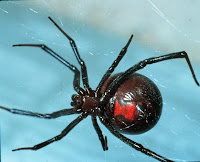Spiders: Spooky or Cool?


With Halloween rapidly approaching, spiders and other creepy crawlers are seen all over town as decoration. Unfortunately, spiders get a bad wrap. Spiders are not the evil, scary, mean animals that common belief leads you to think. Most spiders are actually extremely beneficial: they eat harmful and nuisance insects in our homes, gardens, and landscape. However, there are two harmful spiders found in Texas that we should all avoid: the brown recluse and black widow.
Black widows are shiny, black, spiders with large abdomens. Black widows have a red or orange hour glass on the underside of their abdomen, which is always noticeable because she hangs upside down from her web. Their webs are cobweb like, and the spider spends most of its time in the web. The black widow bite is a neurotoxin and affects the nervous system, with pain usually localizing in the abdomen or back.
Brown recluses are hairy, long legged, brown spiders with the image of a fiddle or violin on their backs. They are rarely larger than a quarter, including legs. Brown recluse venom is a cytotoxin and causes necrosis of the skin, however, most bites heal without leaving a scar.
With both spiders, the reaction of person exhibits depends on the location of the bite, how sensitive the individual is, and how much venom is injected.
These spiders are very reclusive, they enjoy hiding in dark, clutter places - places you are already afraid to venture! Most people are bitten when they brush up against their hiding place. Neither spider aggressively looks for a human to bite, or comes out at night to bite you over and over again!
To learn more about these spiders and others, check out the AgriLife spider publication E-408 at. http://agrilifebookstore.org. Or come see my program at the Bexar County Extension office, October 30th from 2-4pm.
Photos can be found at http://insects.tamu.edu/fieldguide. Pictures taken by John Jackman.


Comments